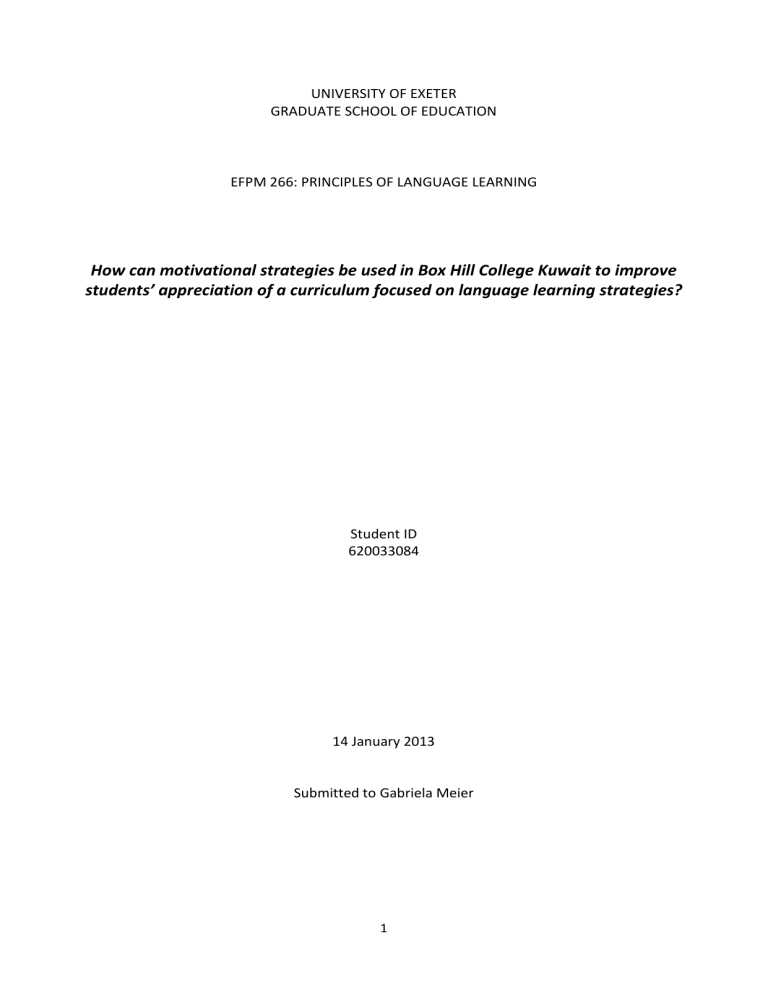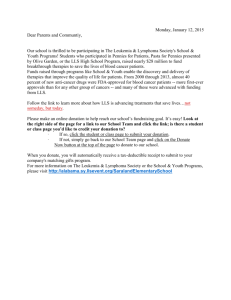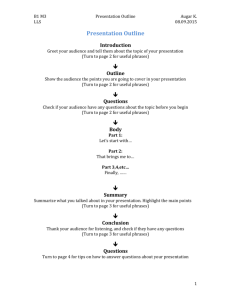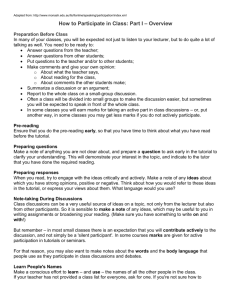266 Final Paper Pearson

UNIVERSITY OF EXETER
GRADUATE SCHOOL OF EDUCATION
EFPM 266: PRINCIPLES OF LANGUAGE LEARNING
How can motivational strategies be used in Box Hill College Kuwait to improve students’ appreciation of a curriculum focused on language learning strategies?
Student ID
620033084
14 January 2013
Submitted to Gabriela Meier
1
Introduction
English is used extensively in Kuwait to conduct everyday business, and this is due in large part to the extremely high number of expatriates making their home in the country. Though the majority of expats do not speak English as an L1, it is the unofficial second language of the country (CIA, 2009), and is sometimes preferred over Arabic as the ‘international language’ used in interaction between speakers of different L1s.
The extensive use of English, coupled with inclusion of the language English instruction at all levels of education, mean that most Kuwaiti students obtain a certain degree of proficiency with English prior to beginning college. It is important to note however, that “the ‘academic’ English required from them in their college studies differ[s] from the English required from them in their everyday lives” (Ed-Dib, 2004), and this situation can prove problematic for Kuwaiti students who choose to attend universities where English is the language of instruction.
Box Hill College Kuwait (BHCK) is a private Australian college for girls in southern Kuwait. The Foundation programme at BHCK consists of three levels meaning that students attend up to three semesters of English study prior to entry into their mainstream programmes. Each level includes Writing, Reading, and
Listening/Speaking classes, while upper levels also attend Maths and Computers. The primary function of the Foundation programme is to prepare students for their mainstream classes which are Bachelors level classes taught by L1 English speakers using Bachelors level English textbooks. The short duration of English study coupled with the impracticality of grouping Foundation students according to mainstream subject areas means that there is insufficient time to teach students discipline-specific English. Thus, the focus of the curriculum has been on the teaching of language learning strategies (LLS), or ‘learning to learn’. It is this focus, and its subsequent effect on student motivation that is proving problematic.
BHCK caters primarily to more conservative families who wish to educate their daughters and, as it has set lower English proficiency and high school GPA entry requirements than other colleges in the country, has a reputation for accepting students who ‘aren’t good enough’ to attend more prestigious schools. During my two years as an instructor at BHCK, I observed that this reputation often means that students beginning at the school are already poorly motivated by past failure and subsequent development of the belief that they are ‘not good students’ or ‘unable to learn’. This lack of motivation is no doubt compounded when students are unable to activate much of their previously used functional English to aid them in their Foundation level studies. I also noted that motivation is affected by a number of cultural and contextual factors including cultural clashes with foreign teachers, discrepancies between their previous learning experience and the expectations of their teachers, family focus on obtaining a degree rather than support during the learning process, and the failure of students to form a student identity because of cultural norms that minimize the importance of a degree for girls. Students are often open in explaining that their attendance and degree are
2
a means to a better marriage and that neither they nor their families have any real expectation of the use of their degree in a future career; this is a cultural norm that has changed little despite advances for education of women over the last 30 years (Meleis, El-Sanabary, & Beeson, 1979).
These cultural and contextual factors alone present a significant challenge to both students and teachers, and this challenge is further complicated when students become frustrated with LLS instruction which is often unclear and presented without an apparent rationale. Thus, in this paper I will explore theories of LLS and ways that theories of motivation can be applied to LLS instruction in an attempt to answer the question
‘How can motivational strategies be used in Box Hill College Kuwait to improve students’ appreciation of a curriculum focused on language learning strategies?’ I will begin with a literature review where I will summarize historical and current theories of LLS and motivation. Next, I will evaluate different approaches to each and outline the theoretical framework to be applied to the essay question. Finally, I will apply the theoretical framework to the specific context of BHCK and offer suggestions for addressing the problem.
Literature Review
This literature seeks to provide an overview of the relevant literature on both language learning strategies and motivation. I will first look at theories of and studies on LLS and LLS instruction before moving onto a review of theories of motivation and motivation strategies. I will conclude this section by summarizing the theoretical framework that I will apply to the problem outlined above.
Language Learning Strategies
Definitions of LLS have been put forth by nearly every prominent academic researching in the field (Chamot
& O'Malley, 1990; Stern, 1983; Wenden, 1987; Cohen A. D., 1990). However, one of the most widely used definitions, and the one used for this paper, comes from Oxford who defines language learning strategies as
“specific actions taken by the learner to make learning easier, faster, more enjoyable, more self-directed, more effective and more transferable to new situations” (Oxford, 1990, p. 8).
Research on LLS dates from the 1970s and was initially carried out with successful students (Chamot,
Barnhardt, El-Dinary, & Robbins, 1996) with researchers hoping to better identify what strategies contributed to their success (Naiman, Frolich, Stern, & Todesco, 1978; Rubin, 1975; Rubin & Thompson,
1982; Stern, 1975). This focus on successful students eventually led researchers to compare strategy use between successful and less successful learners (Chamot, O'Malley, Küpper, & Impink-Hernandez, 1987;
Chamot, Küpper, & Impink-Hernandez, 1988). A significant number of studies showed, perhaps not surprisingly, that higher student proficiency was positively related to more frequent and varied use of LLS
(Cohen A. D., 1998; Park, 1997; Wharton, 2000).
3
One primary goal of LLS researchers has been to define, identify, and categorize specific strategies, and Ellis suggests that the resulting range of differing and sometimes overlapping sets and categories is an impediment to clearly defined LLS research (Ellis, 1985). However, three basic categories including metacognitive, cognitive, and socioaffective strategies have been widely recognized and are mentioned repeatedly in various research. (Chamot et al., 1996) Oxford also recognizes these three categories (in addition to memory and compensation categories) and provides examples of each type. Metacognitive strategies include learner behaviours such as activating previous knowledge and planning and evaluating learning. Cognitive strategies include learner behaviours such as practicing including repetition, analyzing language, and taking notes. The final category, socioaffective strategies, include learner behaviours such as creating favourable physical and emotional learning conditions, asking questions, and working with others to draw on their expertise (Oxford, 1990:17)
However, it is important to note that Oxford does point out that most research has focused heavily on the cognitive and metacognitive strategies with socioaffective strategies being largely neglected (Oxford, 1990).
This neglect is apparent not only a review of the literature, but also in the focus of LLS instruction. In my experience, materials often focus on LLS that improve learning efficiency with less regard paid to the learning environment and cooperative learning. This is reflected in the importance many teachers and schools place on assignment deadlines and the ability to work independently. I would suggest that a stronger focus on socioaffective strategies in the research and literature could lead to a greater focus on them in practice where more favourable learning conditions would likely prove helpful to students.
In addition to defining and categorizing LLS, researchers have analyzed the implications of various methods of LLS instruction in the classroom. A number of researchers have argued that it is useful and even necessary to provide students with strategies training (Wenden, 1986; Cohen & Macaro, 2007; Oxford,
Cohen, Crookall, Lavine, Nyikos, & Sutter, 1990), but disagreements arise over methods including informed or blind (Oxford et al., 1990; Flaitz, Feyten, Fox, & Mukherjee, 1995).
Informed LLS instruction is an explicit method sometimes referred to as awareness training (Oxford, 1990) and is distinguished by the characteristic of providing students with a rationale for strategy use (Nyikos,
1996) and an explanation of why they are needed/useful (Flaitz et al., 1995). Though this approach is useful in providing students with a concrete rationale for the use of LLS, I believe it fails to provide students with a chance to apply the LLS in practice where, in my experience, students often equate the importance of a particular skill with the amount of time they are required to spend practising it. It also places a large amount of responsibility on the student to conduct their own research into the use of specific LLS, and this may be less successful than guided explanations by teachers. In addition, Chamot cautions that in this type of LLS
4
instruction can lead to over teaching strategies which provides learners with too many choices, many of which they will not use, and this causes frustration (Chamot A. U., 1993).
Blind LLS instruction is a more implicit method sometimes referred to as long-term training (Oxford, 1990), and is achieved through the completion of activities which require the use of specific strategies. In this type of instruction, students are not provided with a rationale for strategy use (Nyikos, 1996), and strategies are practiced without discussion of how they are used or transferred (Flaitz et al., 1995). Brown describes one of the major flaws of this type of instruction by suggesting that blind instruction leads to success with specific tasks used in practice but fails to develop a student’s ability to generalize the use of the strategy to other learning situations (as cited in Flaitz et al., 1995) because it leaves them largely unaware that a LLS was being used at all.
Because of the general consensus that LLS are useful to students, a number of studies have been conducted to assess student use of LLS and the connection to proficiency and student success. However, it is worth noting at this point that there is a deficiency of literature relating specifically to the education situation in
Kuwait, and little (if any) is related specifically to higher education of women in this context. Nevertheless, a review of research conducted in a number of other Arabic EFL contexts can shed light on Kuwait as a similar context.
The importance of fairly rigid traditional gender roles in many Arabic speaking countries means that the role of gender and its relation to LLS has been of particular interest. Yet looking at the research, a number of contradicting results arise. Several researchers outside the Arabic EFL context found that females use a wider variety of LLS than males do (Oxford, Nyikos, & Ehrman, 1988; Green & Oxford, 1995). However, one study in Saudi Arabia found little difference in LLS use between males and females with the exception of higher reported use of social strategies by females (Alhaisoni, 2012). Additionally, a rare study from Kuwait as well as one in Egypt both found that in fact male students are likely to use a broader range of LLS including social strategies like naturalistic practice (Ed-Dib, 2004), while girls rely more on repetition and memorization strategies (Daif-Allah, 2012). Both of these studies point out that in this case, it is not only gender, but more specifically the gender roles assigned and promoted by the culture that shape the results with girls having less opportunity for and higher levels of social anxiety related to natural social interaction.
Another interesting area of LLS research is teacher education in LLS training. A number of studies have pointed out that, while it is widely agreed that LLS instruction improves student success (Chamot A. U., 1993;
Oxford, 1990), many teachers have little formal training in this type of instruction and are therefore uncomfortable using it (Flaitz et al., 1995). In addition, a lack of solid theory around LLS instruction means
5
that methods are “based largely on convenience, intuition, and/or some level of idiosyncrasy” (Plonsky,
2011)
Motivation
There is no one agreed definition of motivation present in the literature, and this is due in part to the various disciplines across which motivation is research and evaluated. However, in turning to Dörnyei as one of the most influential researchers on motivation in SLA, I will define motivation as the reasons “why people decide to do something, how long they are willing to sustain the activity and how hard they are going to pursue it”
(2001:8)
Theories of motivation in second language acquisition (SLA) find their beginnings in social psychology research from the 1950s which looks at motivation in relation to the interaction of different communities.
However, SLA motivation theory differs from motivation theory in other disciplines as L2 learners have to acquire not only linguistic knowledge, but knowledge of the identity of L2 speakers (Gardner R. C., 1979).
Gardner and Lambert pioneered thinking in this area with their idea of integrative motivation, or a person’s desire and willingness to integrate and interact with the L2 community, and instrumental motivation, or a person’s practical need to learn a new language (1972). This theory and continued research by Gardner in which he expands the levels and types if integrative motivation (Gardner R. , 2001) continue to influence L2 motivation research, but in 1991, Crookes and Schmidt were among a number of researchers to call for a revitalization of SLA motivation research (1991), and subsequent research shows a move to more cognitive situated theories.
Cognitive theories of motivation shift the focus from macro perspectives of motivation in relation to community interaction to theories of motivation in specific learning contexts (Dörnyei & Ushioda, 2012) and incorporate ideas of self-determination which look at both intrinsic (internal) and extrinsic (external) motivation. This period of SLA motivation research is also characterized by the inclusion of theories of attributions or “perceived reasons for success and failure resulting from self-questioning” (Peacock, 2012) which ask learners to assess what drives their success or failure in L2 and includes internal motivational factors like love of L2 and external factors like teacher praise. However, as researchers began to consider the myriad of factors affecting motivation including not only the context but time, research moved into a process-oriented phase.
Process-oriented motivation theory is characterized in part by a differentiation between motivation to begin learning another language, and motivation during and after the language learning process. Dörnyei and Otto
(1998) clearly delineate three time related stages of motivation including the pre-actional stage which
6
involves setting goals and taking action, the actional stage involving performing task relevant to the goal and ongoing appraisal, and the post-actional stage which evaluates past action and looks at further planning
(Dörnyei, 2003). Yet researchers began to realize that these theories viewed motivation as largely internal and failed to account for the effects of interaction with external factors. In an attempt to overcome this gap, research moved into the socio-dynamic stage which is currently ongoing and looks at a motivation as internal but constantly shifting due to influences of context and time. Two major theories to develop as part of this phase are Ushioda’s Person-in-Context theory and Dörnyei’s L2 Motivational Self-System, both of which are outlined in more detail below.
Though Gardner’s original ideas of integrativeness and instrumentality are thought to be an overly simplistic way of looking at motivation, they are still relevant when included as part of a more complex view.
Dörnyei’s L2 Motivational Self System theory incorporates Gardner’s theories with ideas of the ideal and
ought selves stemming from psychology (Markus & Nurius, 1986; Markus & Ruvolo, 1989; Higgins, 1987), and considerations of the context. Thus, motivation is a combination of a desire to reach our ideal self or person we would like to be, to gain attributes that we feel we ought to have, and contextual factors such as our learning environment and previous learning experience. In considering the context, Dörnyei also stresses the impact of significant others like teachers, peer groups, and families and how these others can shape motivation (2009).
This theory, when coupled with the practical suggestions offered by Dörnyei (2001) for the implementation of motivation strategies is invaluable in understanding and promoting student motivation. The L2
Motivational Self System theory can help teachers and students better understand how motivation is constructed and therefore better address problems. As a teacher I am especially grateful for Dörnyei’s list of specific and concrete suggestions for generating and maintaining student motivation as these translate directly into action I am able to take to improve the motivation and experience of my students (2001).
Ushioda’s Person-in-Context view has also arisen during the current socio-dynamic stage, and like Dörnyei’s
L2 Motivational Self System, it attempts to take into account incredibly complex and numerous factors and interactions by looking at motivation and its relation to self identity and context. Specifically, Ushioda expands the ideas of the ideal and ought self by arguing that it is not only future selves that drive motivation, but current self-identities (2009). These identities are “likely to be constantly constructed, negotiated, and reconstructed through our interactions with others and through our changing experiences and relations with the social world” (Ushioda, 2011)
Ushioda’s theory takes on the monumental task of combining an overwhelmingly large number of factors into an explanation of motivation. This approach is useful in illustrating the intricacy of the factors affecting
7
motivation and helps move researchers and teachers towards a better understanding of the fluidity of motivation. However, the sheer complexity of the theory is likely to prove cumbersome for teachers as part of a practical assessment of student motivation, and thus fails to provide the practical means of increasing student motivation in the same way as Dörnyei.
In addition to analyzing the factors affecting student motivation, SLA motivation researchers like Dörnyei have sought to develop motivation strategies that can be utilized by teachers to positively affect student motivation. Dörnyei offers three phases of increasing motivation including generating initial motivation, maintaining motivation, and encouraging self-evaluation (2001, p. 29). For each phase, he offers an extensive list of specific actions that can be taken to help with learner motivation. For instance, initial motivation can be generated by presenting peer role models and increasing students’ expectations of success. Motivation can be maintained by teaching learner strategies and promoting learner autonomy, and
self-evaluation is promoted by increasing learner satisfaction and using grades in a motivating manner
(Dörnyei, 2001).
Research on motivation abounds across a number of disciplines, and this research has driven the formation of motivation theories like those outlined above. However, current research lags behind theoretical advances in the field, and more specifically as it relates to SLA. As noted, researchers now believe that the context and significant others play a pivotal role in motivation, and the factors associated with these vary widely across different cultures. Thus, the sheer complexity of motivational factors and their connection to specific contexts and cultures suggests that specific studies are unlikely to produce findings which can be generalized across different situations. In this respect, it becomes difficult to situate current motivation theory in the context of higher education for girls in Kuwait as little literature exists combining the most current theory to the Arabic EFL context.
Theoretical framework for application to the problem
The literature review outlines the history of and current thinking in both theories of LLS and motivation in L2 contexts, and it is important that key ideas from both be considered to best address the question ‘How can motivational strategies be used in Box Hill College Kuwait to improve students’ appreciation of a curriculum focused on language learning strategies?’ Of particular importance are the implications of various methods of and teacher training in LLS instruction, the consideration of complex factors of motivation related to the context, and application of motivational strategies.
8
Discussion
The complexity of applying LLS and motivation theories while considering contextual factors requires that this discussion section be divided similar to the literature review. First I will look at aspects of LLS in relation to the context of the Foundation Programme at BHCK and then move into a discussion of motivation theories and their relevance to the context. The section will conclude with an overview of several recommendations for using the theories outlined to address the essay question.
Language Learning Strategies in Context
Though it is widely agreed that the use of LLS increases student success, there is some disagreement over the most effective method of LLS instruction. In particular, the question of informed versus blind instruction divides researchers and teachers. This question is particularly relevant at BHCK as LLS are already being taught using the blind method. For example, the level 3 reading and writing book, Weaving It Together
(Broukal, 2010), asks students to practice a number of LLS like predicting what they will read, guessing meaning from context, and outlining prior to writing, yet does not provide any explicit instruction on the need for or use of these strategies. While using this textbook during my time at BHCK, students voiced uncertainty about why they had to repeatedly perform the same kinds of tasks relating to topics which were ultimately not relevant to the class or their future studies. This failure to understand the rationale behind activities causes frustration which in turn lowers student motivation.
If students are unclear about the reasons behind the activities covered in class, the obvious place to turn for explanation would be the teachers. However, BHCK employed teachers from a wide range of cultural, educational, and experiential backgrounds, and I observed that many seemed uncomfortable with defining, using, and explaining relevant LLS. Indeed, even when members of the faculty appeared clear on the definition and usefulness of a specific strategy, they were often at a loss as to how to explain it to students or assess successful LLS student use of the strategy. This meant that students were left unclear about what was expected of them at the outset of activities which practiced LLS, and were frustrated by unclear and inconsistent marking of completed LLS activities. This, in addition to the lack of guidance and rationale for classroom activities practising LLS, further exacerbated student frustration and decreased student motivation.
Motivation in Context
The context specific factors affecting student motivation are extremely multifaceted in any situation, and the context of BHCK is no exception. Two factors of particular importance and complexity are the role of women in Kuwaiti culture, and the importance of significant others for women in higher education.
9
One of the most notable cultural factors affecting the motivation of students in the BHCK context is the role of women in Kuwait, which appears to have changed little over the last 50 years. Though the role of women is highly nuanced and multifaceted, there are several aspects which have special bearing on the motivation of female students. The first and most notable is the value of a good marriage which often subsumes or is the driving force behind all other future goals for girls. As hinted at in the introduction, “The primary motivation for a woman to obtain education is to enhance her desirability as a wife and mother.
Responsibilities beyond those of wife and mother are sometimes assumed but remain of secondary value and are readily sacrificed” (Meleis, El-Sanabary, & Beeson, 1979:123). The second factor I observed is the relatively young age at which girls begin to consider and ‘train’ for marriage. Through numerous discussions with students, I learned that many girls worry about remaining single past their early 20s, and that many receive what they call ‘wife training’ at home by being given almost sole responsibility for younger siblings and housework. Thus, many girls are not only receiving significant encouragement for a future that does not require education, but are often not allowed the time necessary to successfully pursue their education.
Significant others including family, teachers, and peer groups are another factor that has a considerable impact on motivation in the BHCK context. If students at BHCK fail to receive encouragement for their education from their families, it is not surprising that this translates into low personal motivation to succeed at school. However, teachers and peer groups are two other groups which exercise considerable influence on the motivation of students at BHCK. Because the majority of teachers at BHCK come from non-Arabic backgrounds, it is perhaps to be expected that conflicts will arise due to cultural differences and discrepancies in expectations between teachers and students. During faculty discussions, one of the most often cited teacher frustrations was lack of learner autonomy and students’ responsibility for their own learning, and teachers admitted that the frustration often made them less understanding and patient with their students. I frequently observed that this lack of understanding, coupled with unfamiliar expectations from teachers caused students to feel overwhelmed and often lose motivation. The final group, student peers, also played a major role in determining levels of motivation. The lack of general motivation outlined in the introduction meant that even high achieving and personally motivated students sometimes seemed to draw back their enthusiasm in order to better integrate with their peers.
This essay has explored theories of LLS and motivation in the context of BHCK in order to answer the essay question, ‘How can motivational strategies be used in Box Hill College Kuwait to improve students’ appreciation of a curriculum focused on language learning strategies?’ I believe that the following recommendations outline practical means for addressing this problem through the application of these theories.
10
Applying LLS Theory in Context
The nature of the BHCK Foundation programme means that it is highly unlikely that the curricular focus will shift away from LLS, and thus it is probable that blind instruction through textbook activities will continue to account for the bulk of classroom time. However, the current dissatisfaction of students coupled with research in the field suggests that it would prove useful for the programme to include more informed instruction. To this end, I would suggest that the inclusion of a once-weekly class providing an overview of and rationale for the use of LLS would help raise student awareness of and appreciation for LLS. This awareness could then be taken into the skills classes where students would likely have a better appreciation for and motivation to participate in activities that practice LLS.
In either case, it is imperative that teachers receive training on LLS and means of teaching them. This type of training would not only help normalize definitions of LLS across a diverse group of teachers, but also provide standard means of explaining and teaching LLS in the absence of guidance from the chosen textbooks. This type of training would also improve teacher confidence and motivation which is likely to translate into higher general class motivation.
Applying Motivation Theory
Though the cultural factors affecting general motivation of students at BHCK cannot be changed, I believe that the application of several simple motivation strategies can help students engage with the LLS focus of the programme and develop clearer ‘student’ identities which will increase motivation. First, BHCK has a number of graduates who continue to be successful in further education and business, and Dörnyei suggests that student motivation can be generated through feedback from these successful peers (2001). I suggest inviting these peers to speak to students in the Foundation programme in order to provide students with a model of success, prompt them to develop an identity which includes education, and better understand the role of learning strategies in future educational success.
Furthermore, it is not surprising that students are more motivated to participate in activities where they feel they are able to be successful. Dörnyei offers several means of increasing learner expectations of success including providing sufficient preparation and guidance for activities as well as a clear understanding of how to successfully complete activities (2001). As noted above, teachers at BHCK struggle to provide this guidance and clear expectations due to a lack of familiarity with LLS instruction and assessment. The teacher training suggested above would provide clearer guidance to teachers which could then be passed on to students. I also believe it would be useful for department management to encourage more collaboration between teachers, a feature which is currently lacking at the school, in order to standardize instruction
11
methods for LLS and assessment criteria. Finally, the development and implementation of consistent marking would also help students better see their own progress and more clearly reflect on their improvement.
This exploration of the BHCK context within the framework of LLS and motivation theory begins to clarify some of the issues that arise in generating and maintaining student motivation with a curriculum focused on
LLS. Thus, the answer to the question of how motivational strategies can be used in Box Hill College Kuwait to improve students’ appreciation of a curriculum focused on language learning strategies is through a combination of LLS teaching methods, increased teacher familiarity with LLS instruction, and the application of motivational strategies such as peer modelling, clear expectations for success, and consistent and clear marking of LLS centred activities.
Conclusion
The application of LLS and motivation strategies to the context of BHCK helps to uncover a number of issues relating to the LLS focused curriculum. Though the lack of student motivation may at first seem to be primarily an issue relating to cultural views of the role of women, the above assessment shows that much of the dissatisfaction regarding the curriculum in fact arises from a failure of teachers to clearly understand LLS and a failure of the programme to provide a combined approach of blind and informed LLS instruction. The rectification of these issues would help create a more motivating environment for students by enabling teachers to better apply a number of motivation strategies. Motivation theory also helps begin to explain how issues of student identity shaped by cultural constructs may be impeding motivation, and provides a number of useful ways to help students incorporate education into their vision of their ideal selves.
I believe that the recommendations I have suggested in this paper are easily transferable to other contexts.
Though it is true that little can be done regarding certain cultural factors of motivation, these suggestions seek to circumvent these issues by creating a learning environment that fosters strong student identity and better understanding and cooperation between teachers and students. Suggestions like teacher training of
LLS cannot fail to be useful in any context as a means of improving teaching practice, and the recommendations for the application of motivational strategies could be applied in any context when coupled with teacher guidance towards specific cultural aspects.
In regards to both LLS and motivation, future research conducted specifically in the Arabic-EFL context is necessary to better understand how these theories manifest themselves in the reality of the unique cultural context of Arab countries. These studies could focus on the discrepancies between teacher and student expectations regarding the use of LLS and learner autonomy which arise from different methods of early
12
learning between Western and Arab countries, and more importantly on factors of motivation specifically related to women seeking higher education in contexts where the traditional and possibly limited role of women seems to present a unique challenge to motivating their successful participation in higher edu cation.
13
Bibliography
Alhaisoni, E. (2012). Language learning strategy use of Saudi EFL students in an intensive English learning context. Asian Social Science , 8(13), 115-127.
Broukal, M. (2010). Weaving it together 4: Connecting reading and writing (3 rd ed.). Boston: Heinle, Cengage
Learning.
Chamot, A. U. (1993). Student responses to learning strategy instruction in the foreign language classroom.
Foreign Language Annals , 26(3), 308-320.
Chamot, A. U., & O'Malley, J. (1990). Learning strategies in second language acquisition. Cambridge:
Cambridge University Press.
Chamot, A. U., Barnhardt, S., El-Dinary, P., & Robbins, J. (1996). Methods for teaching learning strategies in the foreign language classroom. In R. Oxford (Ed.), Language learning strategies around the world:
Cross-cultural perspectives (Technical Report #13) (pp. 175-189). Honolulu: University of Hawai'i
Press.
Chamot, A. U., Küpper, L., & Impink-Hernandez, M. V. (1988). The study of learning strategies in foreign
language instruction: Findings of the longitudinal study. McLean, VA: Interstate Research Associates.
Chamot, A. U., O'Malley, J. M., Küpper, L., & Impink-Hernandez, M. (1987). A study of learing strategies in
foreign language instruction: First year report. Rosslyn, VA: InterAmerican Research Associates.
CIA, Central Intelligence Agency (2009). Kuwait. Retrieved December 21, 2012, from The World Factbook
2009: https://www.cia.gov/library/publications/the-world-factbook/geos/ku.html
Cohen, A. D. (1990). Language learning: Insight for learners, teachers, and researchers. New York: Newbury
House/Harper & Row.
Cohen, A. D. (1998). Strategies in learning and using a second language. New York: Longman.
Cohen, A. D., & Macaro, E. (2007). Language learner strategies: 30 years of research and practice. Oxford:
Oxford University Press.
Crookes, G., & Schmidt, R. (1991). Motivation: Reopening the research agenda. Language Learning , 41(4),
469-512.
Daif-Allah, A. (2012). Beliefs about foreign language learning and their relationship to gender. English
Language Teaching , 5 (10), 20-33.
Dörnyei, Z. (2003). Attitudes, orientations, and motivations in language learning: Advances in theory, research, and applications. In Z. Dörnyei (Ed.), Attitudes, orientations and motivations in language
learning (pp. 3-32). Oxford: Blackwell.
Dörnyei, Z. (2001). Motivational strategies in the language classroom. Cambridge: Cambridge University
Press.
Dörnyei, Z. (2009). The L2 motivational self system. In Z. Dörnyei, & E. Ushioda (Eds.), Motivation, language
identity and the L2 self (pp. 9-42). Bristol: Multilingual Matters.
14
Dörnyei, Z., & Otto, I. (1998). Motivation in action: A process model of L2 motivation. Working Papers in
Applied Linguistics (Thames Valley University, London) , 4, 43-69.
Dörnyei, Z., & Ushioda, E. (2012). Motivation. In S. Gass, & A. Mackey (Eds.), The Routledge handbook of
second language acquisition (pp. 396-409). New York: Routledge.
Ed-Dib, M. (2004). Language learning strategies in Kuwait: Links to gender, language level, and culture in a hybrid context. Foreign Language Annals , 37 (1), 85-95.
Ellis, R. (1985). Understanding second language acquisition. Oxford: Oxford University Press.
Flaitz, J., Feyten, C., Fox, S., & Mukherjee, K. (1995). Raising general awareness of language learning strategies: A little bit goes a long way. Hispania , 8 (2), 337-348.
Gardner, R. C. (1979). Social psychological aspects of second language acquisition. In H. Giles, & R. St Clair
(Eds.), Language and social psychology (pp. 193-220). Oxford: Blackwell.
Gardner, R. (2001). Integrative motivation and second language acquisition. In Z. Dörnyei, & R. Schmidt
(Eds.), Motivation and second language acquisition (Technical Report #23) (pp. 1-19). Honolulu:
University of Hawai'i, Second Language Teaching and Curriculum Center.
Gardner, R., & Lambert, W. E. (1972). Attitudes and motivation in second language learning. Rowley, MA:
Newbury House.
Green, J. M., & Oxford, R. (1995). A closer look at learning strategies, L2 proficiency, and gender. TESOL
Quarterly , 29 (2), 261-297.
Higgins, E. T. (1987). Self-discrepancy: A theory relating self and affect. Psychological Review , 94, 319-340.
Markus, H. R., & Ruvolo, A. (1989). Possible selves: Personalized respresentations of goals. In L. Pervin (Ed.),
Goal concepts in personality and social psychology (pp. 211-241). Hillsdale, NJ: Lawrence Erlbaum.
Markus, H., & Nurius, P. (1986). Possible selves. American Psychologist , 41(9), 954-969.
Meleis, A. I., El-Sanabary, N., & Beeson, D. (1979). Women, modernization, and education in Kuwait.
Comparative Education Review , 23 (1), 115-124.
Naiman, N., Frolich, M., Stern, H. H., & Todesco, A. (1978). The good language learner. Toronto: Ontario
Institute of Studies for Education.
Nyikos, M. (1996). The conceptual shift to learner-centered classrooms: Increasing teacher and student strategic awareness. In R. Oxford (Ed.), Language learning strategies around the world: Cross-cultural
perspectives (Technical Report #13) (pp. 109-118). Honolulu: University of Hawai'i, Second Language
Teaching & Curriculum Center.
Oxford, R. (1990). Language learning strategies: What every teacher should know. Boston: Heinle & Heinle.
Oxford, R., Cohen, A., Crookall, D., Lavine, R., Nyikos, M., & Sutter, W. (1990). Strategy training for language learners: Six situational case studies and a training model. Foreign Language Annals , 22 (3), 197-
216.
15
Oxford, R., Nyikos, M., & Ehrman, M. (1988). Vive la difference? Reflections on sex differences in use of language learning strategies. Foreign language annals , 21 (4), 321-3219.
Park, G. P. (1997). Language learning strategies and English proficiency in Korean university students. Foreign
Language Annals, 30(2), 211-221
Peacock, M. (2012). Attribution and learning English as a foreign language. ELT Journal , 64 (2), 184-193.
Plonsky, L. (2011). The effectiveness of second language strategy instruction: A meta-analysis. Language
Learning , 61 (4), 993-1038.
Rubin, J. (1975). What the "good language learner" can teach us. TESOL Quarterly , 9(1), 41-51.
Rubin, J., & Thompson, I. (1982). How to be a successful language learner. Boston: Heinle & Heinle.
Stern, H. H. (1983). Fundamental concepts of language teaching. Oxford: Oxford University Press.
Stern, H. H. (1975). What can we learn from the good language learner? Canadian Modern Language Review,
31(4), 304-318.
Ushioda, E. (2009). A person-in-context relational view of emergent motivation, self and identity. In Z.
Dörnyei, & E. Ushioda (Eds.), Motivation, language identity and the L2 self (pp. 215-228). Bristol:
Multilingual Matters.
Ushioda, E. (2001). Language learning at university: Exploring the role of motivational thinking. In Z. Dörnyei,
& R. Schmidt (Eds.), Motivation and second language acquisition (Technical Report #23) (pp. 93-126).
Honolulu: University of Hawai'i, Second Language Teaching and Curriculum Center.
Ushioda, E. (2011). Language learning motivation, self and identity: current theoretical perspectives.
Computer Assisted Language Learning , 24 (3), 199-210.
Wenden, A. (1986). Incorporating learner training in the classroom. System , 14(3), 315-325.
Wenden, A. (1987). Metacognition: An expanded view of the cognitive abilities of L2 learners. Language
Learning , 37 (4), 573-597.
Wharton, G. (2000). Language learning strategy use of bilingual foreign language learners in Singapore.
Language Learning, 50(2), 203-243
16







